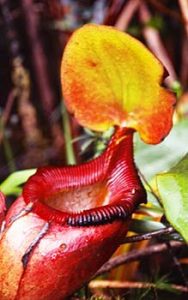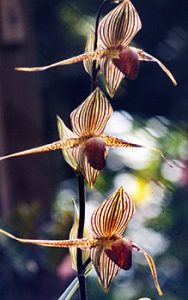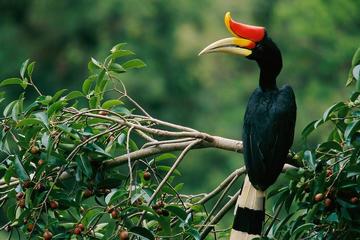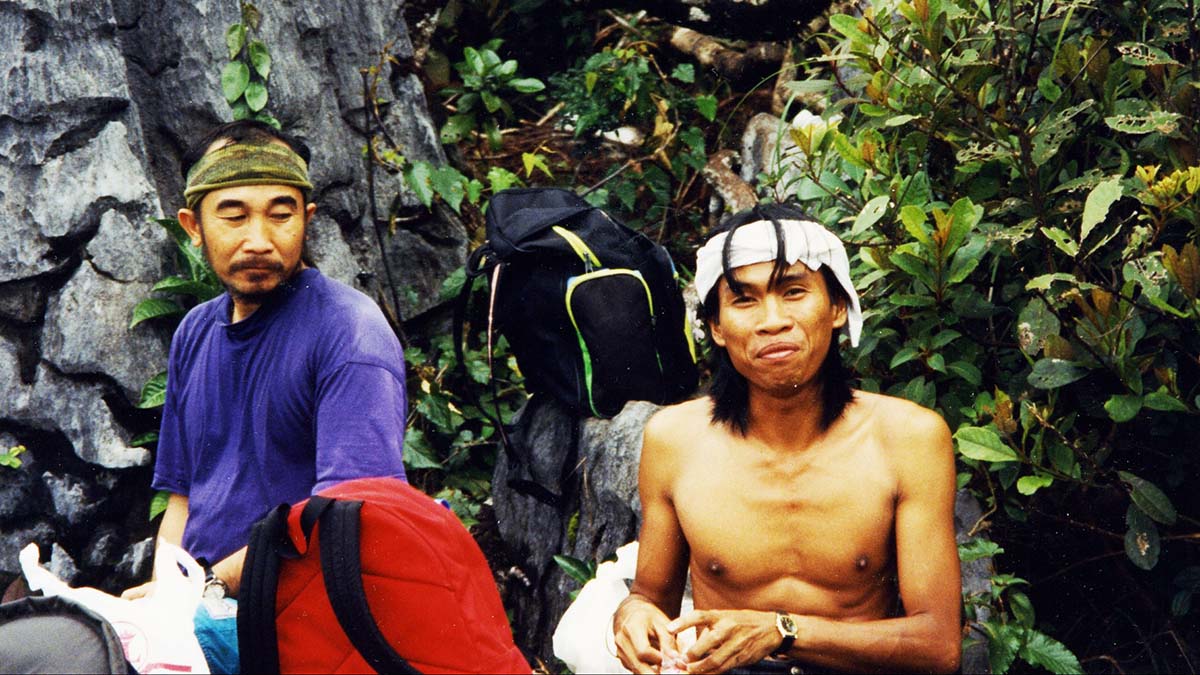
by Martin Kafer
“Oh no! we are stuck!” Esther cries in dismay. The Land Rover, driven by a quiet native man, is mired down deeply. We are on the way to the trailhead for a mountain trek to view the Mulu Pinnacles and now we are stopped in a huge muddy section of the narrow, tree lined jungle track that follows the shore of the Menilau River. The driver tries to pull his way out forward and backward without any luck and, in desperation, finally commands with a shout: “Everybody out and walk along the track!”
Everybody means our local guide Sham and the two of us, my wife and myself. With the vehicle emptied of passengers he is able to get the mud-spattered car onto solid ground, hurray! We can get back in again and then are bumped for about another hour’s slow ride closer to today’s final destination, camp #5 in Gunung Mulu Park. But then suddenly the driver stops again just before we hit a second, larger and impassable looking mucky bit. We are shooed out of the car, there is no choice now, and we have to continue on foot. Sham shoulders his large bundle and we both put on our daypacks, grab our hiking poles, and I strap on my camera bag last.
Our young, good looking native guide, Sham, whose services we had arranged two days earlier at a travel office in the town of Miri on Borneo’s Northwest coast, has joined us at the Royal Mulu Resort. This luxury lodge has two larger service buildings and quite a few smaller guest bungalows, all built from local wood and set on an elevated, snake-proofed platform. For guests the access is by small plane from Miri to the nearby gravel airstrip carved out of the forest along the Menilau River, it is the only way for tourists to get to this remote, fantasy vacation place.
The whole complex was developed by a Japanese hotel chain in the verdant jungle about a hundred km Southeast of Miri. During our first full day at Royal Mulu we joined a small group for a fascinating excursion to one of the nearby karst limestone caves festooned with myriads of glistening stalactites and stalagmites. The quiet beauty of the cave was alive with swarms of (free-tailed) bats, many flying in and out the entrance and others hanging quietly on the walls. Later in the afternoon back at the resort we enjoyed some soothing swims in the lavish, Jacuzzi equipped swimming pool.
On the morning of the trek Sham came to the door of our bungalow and immediately offered an effusive greeting in his stilted English and right after he added with a smile: “This is only my second guiding trip, I hope you are both happy at the end!” On our three-day wilderness hiking trip he will have to carry the heavy stuff, including food and cooking gear, all in a large woven bamboo basket with ridiculous shoulder straps made from string. When we pitied him he laughed: “No sweat, I am used to it!”
A short twenty-minute walk along the muddy track from where we were so unceremoniously dropped off, Sham stops suddenly. He points at the unfriendly looking, fast flowing and oily green Menilau river and says: “Here is the place where we have to cross!”
There is only one option to get to the other shore, we have to wade with boots off and pants rolled way up. Esther ties the bootlaces and hangs the boots from her neck and puts rubber sandals on, Sham and I do the same to our boots and the two of us go barefoot. The bottom is sandy, the water is quite warm, the current is very strong and the waves reach part way up my thighs. By walking side by side with Sham in the middle and all three of us holding onto our hiking poles as a steadying brace, we manage to reach the far side without stumbling or getting too wet.
Safely back on solid ground on the other shore we begin the hike in the big trees of the park, a wonderful contrast to the road side of the river outside of the park, which has been extensively logged. We follow a flat trail with lots of shade – even the hot humid air feels good. We hear lots of birds sing and some frogs, but are unable to spot anything moving in the dense forest as we are trekking along slowly through heavy underbrush, still wet from the previous days rain. Further along the rough trail we easily cross two small fast running side creeks on stepping stones. After about three hours of steady hiking we arrive at camp #5: a shabby looking duo of wooden huts huddled in the narrow Menilau river canyon under the steep limestone cliffs of Gunung Mulu. There is just enough daylight left so the two of us can have a quick swim in a calm pool adjoining the river while Sham is brewing tea at the hut. We just make it back safely by about six when darkness falls like a curtain and a tropical downpour starts with a thunderous drumming on the sheet metal roof.
To our and Sham’s dismay the sleeping mats and blankets, supposedly always stored in the huts, as we had been assured by him, are nowhere to be found. The two long nights we spend on the bare wooden boards with pack sacks as pillows and some spare clothes as mattresses turn out to be ordeals – bruised hips, mostly sleepless nights with only short naps to relieve the misery. This is especially ironic since we spent the previous two nights in the lap of luxury at the five star Royal Mulu Resort.
To make life at hut #5 even more difficult, the battery for the lights, fed by solar panels, is low due to many days of cloudy weather. The kitchen area alone is lit off and on, yet Sham cooks and serves us what turns out to be an excellent dinner, which we enjoy inside followed by tea on the front steps. The rain has stopped for a while and we can watch the fireflies flitting around. The no-see-ums fortunately stopped their stinging activities when it got dark.
Morning cannot come too soon for us, luckily the sun is out, as Sham had predicted in the evening. After a quick breakfast, we set off in the early heat of the new day with Sham leading the way. The fourth member of the party is a park ranger, who has somehow appeared out of nowhere and volunteers to come with us. The trail soon steepens with roots, limestone boulders, long steps in slippery dirt and often thorny tree branches in the way.
We stop a few times for a rest, a drink of water and some dried fruit. The hike is on a narrow, but well marked trail straight up the steep mountain side, which is festooned with lush vegetation – trees, roots, giant ferns, bushes, rocks, dirt, hat grabbers and eye pokers. The sweat pours off me and I am soaked through. It is a relentless climb until we come to a flatter area, where there are many deep and dark pits in the karst limestone. The smaller ones we have to jump across, but the larger ones have been bridged with slippery planks or metal beams. It is quite a balancing act to cross on one or two narrow girders without railings over the gaping black holes: fortunately, we get a helping hand from our guide and the ranger, one at each edge.
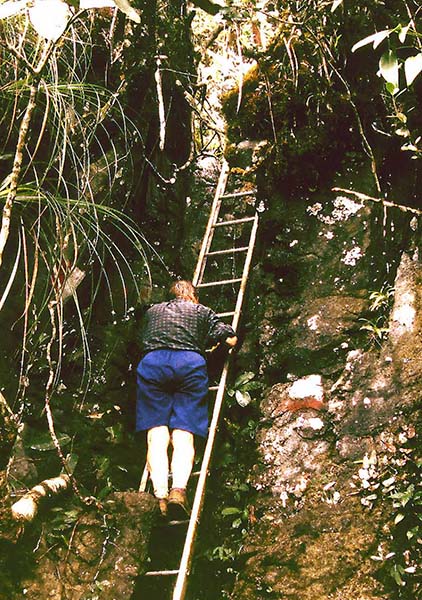 To make the trip more exciting we have to climb aluminium ladders for many steep or vertical rock sections. A total of fifteen ladders, Sham tells us, since he was a member of the trail crew that installed them. This trek turns out to be quite a workout for the old legs and arms. The hiking poles are life savers even if they are sometimes in the way, dangling from our wrists, as we scramble up the many ladders.
To make the trip more exciting we have to climb aluminium ladders for many steep or vertical rock sections. A total of fifteen ladders, Sham tells us, since he was a member of the trail crew that installed them. This trek turns out to be quite a workout for the old legs and arms. The hiking poles are life savers even if they are sometimes in the way, dangling from our wrists, as we scramble up the many ladders.
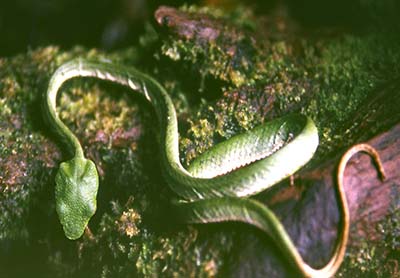 I have just reached the top rung of another steep ladder leading to a wide, rocky platform when I come face to face with a snake coiled on a boulder, staring at me. “Watch out! a snake here, it’s a green one!” I shout as a warning to Esther who is climbing on the ladder just below me. “It’s only a small pit viper!” is Sham’s reassuring cry. I am lucky enough to have the camera ready, the little creature must be scared because it stays absolutely motionless while I quickly take a shot.
I have just reached the top rung of another steep ladder leading to a wide, rocky platform when I come face to face with a snake coiled on a boulder, staring at me. “Watch out! a snake here, it’s a green one!” I shout as a warning to Esther who is climbing on the ladder just below me. “It’s only a small pit viper!” is Sham’s reassuring cry. I am lucky enough to have the camera ready, the little creature must be scared because it stays absolutely motionless while I quickly take a shot.
Finally, after nearly four hours of strenuous ascent we reach our goal, the Pinnacles view spot, congratulations all around, we made it, picture time! The panorama of the many sheer limestone pinnacles we can see across the deep canyon is very impressive, especially with the late morning mists drifting around the top of the steep, pyramid shaped rock towers. It’s a unique and once in a life time experience and to me, worth all the drudge and toil of the climb.
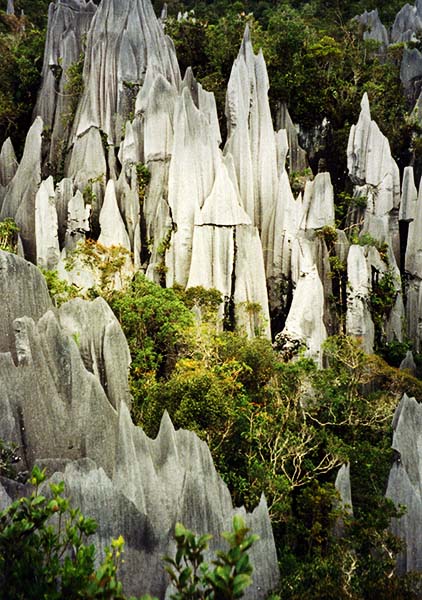 Within less than half an hour the view of the fantastic limestone “forest” is obscured by the lowering clouds. As a consolation, we have a nice lunch and a good rest with leisure to admire the beautiful red throated pitcher plants growing profusely on the inside edge of the platform and nearby a small garden of white Impatiens flowers.
Within less than half an hour the view of the fantastic limestone “forest” is obscured by the lowering clouds. As a consolation, we have a nice lunch and a good rest with leisure to admire the beautiful red throated pitcher plants growing profusely on the inside edge of the platform and nearby a small garden of white Impatiens flowers.
The trek down to camp #5, the second painful night on the boards and the long hike out to the river in heavy tropical rainfall are a bit of a blur, but we certainly remember being pounded by a continuous downpour in the lush forest undergrowth. This day provides us with our first unpleasant and messy encounter with blood sucking leeches which Sham tells us should just be ripped out of the skin, since the bleeding will clean out the “poison”! This procedure was especially painful for Esther who, at the end of the trip, discovered that two leeches had fastened themselves near her private parts!
On the other hand, the heavy rains turn out to be very helpful, since the resort’s boatman can use the swollen Menilau river to navigate his large motorized dugout right to the spot where we had to ford on foot two days ago. We are quite pleased when he arrives with a smile, serves up a nice picnic lunch and then takes us in the boat along the flooding river quickly right back to the Royal Mulu hotel and airstrip, no complaints from us about a shorter, smoother and more comfortable return trip.
That same afternoon we fly back to Miri and on to Kuching for more Borneo adventures.
If You Go:
The most important probably is to make early reservations for the expensive, fly-in (from Miri) accommodation and the obligatory local guide, the jungle hike is quite remote and may-be difficult to arrange. The other three factors for a successful hike are: you have to be physically fit, be prepared for hot and exhausting bush travel and put up with the bugs etc. while enjoying a unique adventure.
About the author:
Martin, who recently celebrated his 90th birthday with a day’s downhill skiing at BC’s Whistler Mountain, was born in Switzerland, has been a mountaineer and ski enthusiast since he was nine years old and a travel adventure seeker since his early twenties. He has, together with his wife Esther climbed over five hundred mountains, including the Matterhorn on their honeymoon. They did many of their climbs during their extensive travels which has taken them to more than sixty countries on five continents during their more than sixty years of marriage. Writing his book of memoirs has been a more recent, but hopefully also successful endeavour.
All photos by Martin Kafer



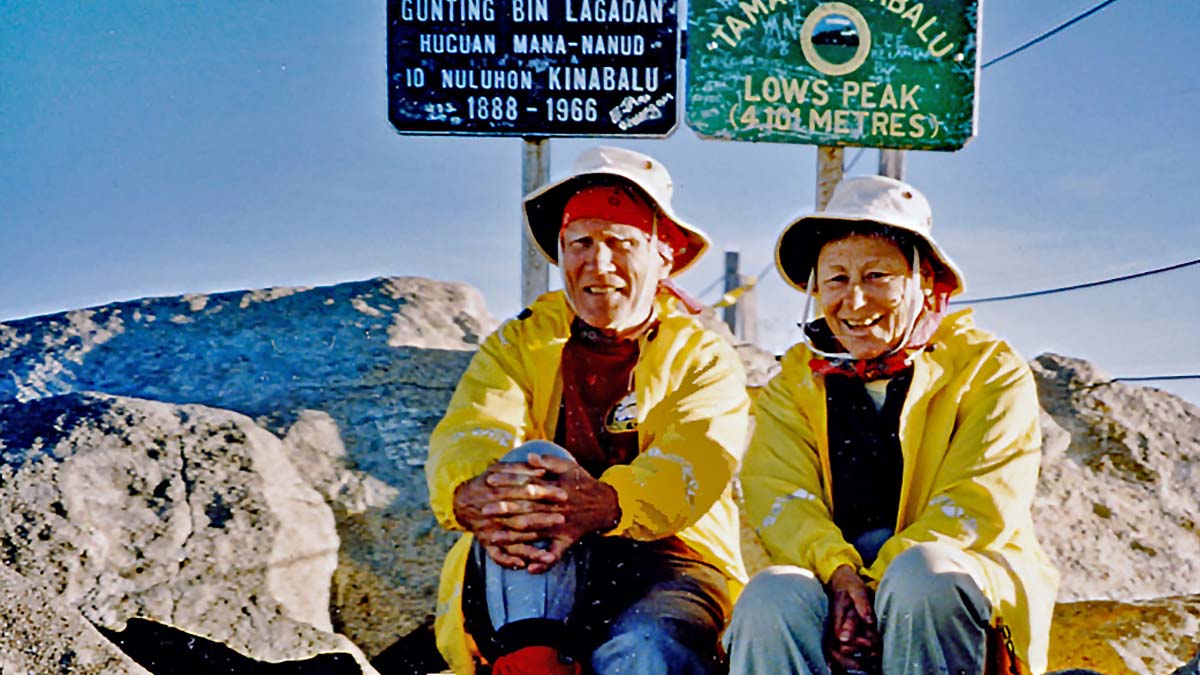

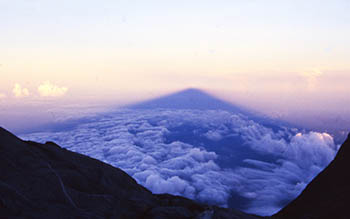 Next day we secure reservations for four nights in a cabin at Kinabalu Park headquarters and one night at the Laban Rata mountain huts high on a ridge of Mt. Kinabalu. A quick visit to the bank next door to change some dollars into ringgit and we are ready to finally have breakfast at the café we had spotted on the way. Our first taste of roti canai telur is a savoury delight – it is a Malay specialty: swirled eggs wrapped in a tasty, extra thin, large crepe made with chickpea flour, and fried on a very hot tin plate. We enjoy it with coffee here and whenever we have the chance during our four weeks in Malaysia.
Next day we secure reservations for four nights in a cabin at Kinabalu Park headquarters and one night at the Laban Rata mountain huts high on a ridge of Mt. Kinabalu. A quick visit to the bank next door to change some dollars into ringgit and we are ready to finally have breakfast at the café we had spotted on the way. Our first taste of roti canai telur is a savoury delight – it is a Malay specialty: swirled eggs wrapped in a tasty, extra thin, large crepe made with chickpea flour, and fried on a very hot tin plate. We enjoy it with coffee here and whenever we have the chance during our four weeks in Malaysia.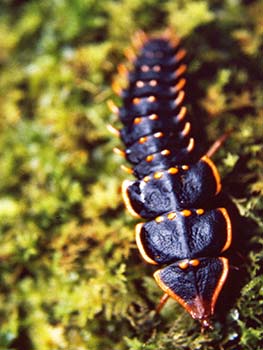 During the next two days we take long hikes in the surrounding hills which are covered in dense forest. These walks on good trails are not just excellent exercise but also delight us with the variety of exotic trees, many with enormous trunks reaching high into the canopy. We enjoy the abundance of fragrant jungle flowers, exquisite orchids of all sizes and colours, and a myriad creepy crawlies, like spiders, ants, moths and butterflies. The most unusual bug we spot turns out be a Trilobite beetle larva, a tiny beautiful black and red creature. At the dinner table I describe it to an Australian visitor, who happens to be an entomologist on a study tour. He exclaims in an envious tone: “You two are so lucky to see one, it is a very elusive insect, I have never seen one myself.
During the next two days we take long hikes in the surrounding hills which are covered in dense forest. These walks on good trails are not just excellent exercise but also delight us with the variety of exotic trees, many with enormous trunks reaching high into the canopy. We enjoy the abundance of fragrant jungle flowers, exquisite orchids of all sizes and colours, and a myriad creepy crawlies, like spiders, ants, moths and butterflies. The most unusual bug we spot turns out be a Trilobite beetle larva, a tiny beautiful black and red creature. At the dinner table I describe it to an Australian visitor, who happens to be an entomologist on a study tour. He exclaims in an envious tone: “You two are so lucky to see one, it is a very elusive insect, I have never seen one myself.